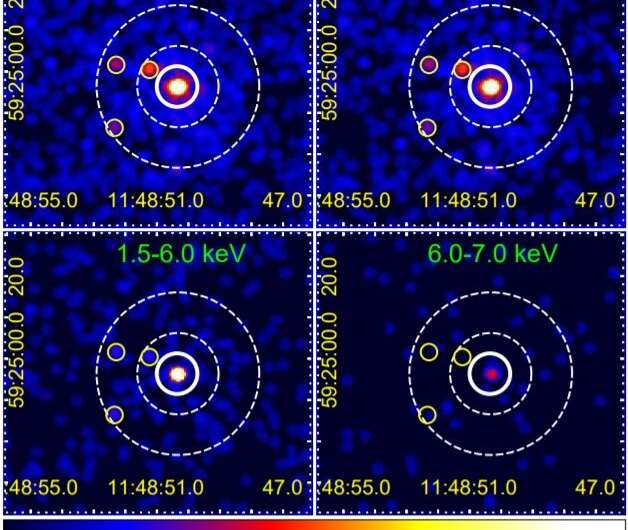Study investigates X-ray emission from the galaxy NGC 3894

Using NASA’s Chandra spacecraft, astronomers have inspected X-ray emission from the center of a young radio galaxy known as NGC 3894. Results of this study, presented in a paper published June 24 on the arXiv pre-print server, yield essential information that could shed more light on the nature of this galaxy and its X-ray emission.
Radio galaxies emit huge amounts of radio waves from their central cores. Black holes at the centers of these galaxies accrete gas and dust, generating high-energy jets visible in radio wavelengths, which accelerate electrically charged particles to high velocities.
Astronomers are especially interested in studying gamma-ray bright radio galaxies as they can provide a unique opportunity to probe the high-energy emitting sites and particle acceleration processes. These sources are observed off-axis, which allows researchers to transversely resolve the fine scale structure of the jet and to investigate its connection with gamma-ray emission.
At a redshift of approximately 0.01, NGC 3894 is an elliptical galaxy hosting a compact radio source designated 1146+596. Observations of 1146+596/NGC 3894 suggest that it is one of the nearest and the youngest low-power radio galaxies. It is also one of only several young radio galaxies detected in the high-energy gamma-ray range.
Although many observations of 1146+596/NGC 3894 have been conducted at radio, infrared, optical and gamma-ray ranges, it lacks any detailed X-ray spectroscopy and imaging. So a team of astronomers led by Karthik Balasubramaniam of the Astronomical Observatory of the Jagiellonian University in Kraków, Poland, investigated the source in X-rays by analyzing the data from the Advanced CCD Imaging Spectrometer (ACIS) detector aboard Chandra.
“Here, we report on the analysis of the archival Chandra X-ray Observatory data for the central part of the galaxy, consisting of a single 40 ksec-long exposure,” the researchers wrote in the paper.
The study found that the core spectrum is best fitted by a combination of a collisionally ionized thermal plasma with the temperature of around 0.8 keV, and a moderately absorbed power-law component. The soft thermal component turned out to be extended on the scale of the galaxy host, while the hard X-ray emission (within the photon energy range 6.0–7.0 keV) seems to originate within the unresolved core.
The research revealed the iron K-alpha line at approximately 6.47 keV, with a relatively large equivalent width of about 1 keV. The iron line is most likely indicative of the X-ray reflection from a cold neutral absorber in the central regions of NGC 3894. The astronomers added that this finding makes NGC 3894 the first high-energy gamma-ray source with the detected K-alpha iron line.
The study also found that the mass of the black hole in the system is about 2 billion solar masses, and that the minimum kinetic power of compact jets in 1146+596 is at a level of 2 tredecillion erg/s.



 Creators of mankind
Creators of mankind Description of “Tall white aliens”
Description of “Tall white aliens” Where they came from?
Where they came from? About hostile civilizations
About hostile civilizations The war for the Earth
The war for the Earth “Tall white aliens” about eternal life
“Tall white aliens” about eternal life Video: “Nordic aliens”
Video: “Nordic aliens” Aliens
Aliens Alien encounters
Alien encounters The aliens base
The aliens base UFO
UFO Technology UFO
Technology UFO Underground civilization
Underground civilization Ancient alien artifacts
Ancient alien artifacts Military and UFO
Military and UFO Mysteries and hypotheses
Mysteries and hypotheses Scientific facts
Scientific facts


















